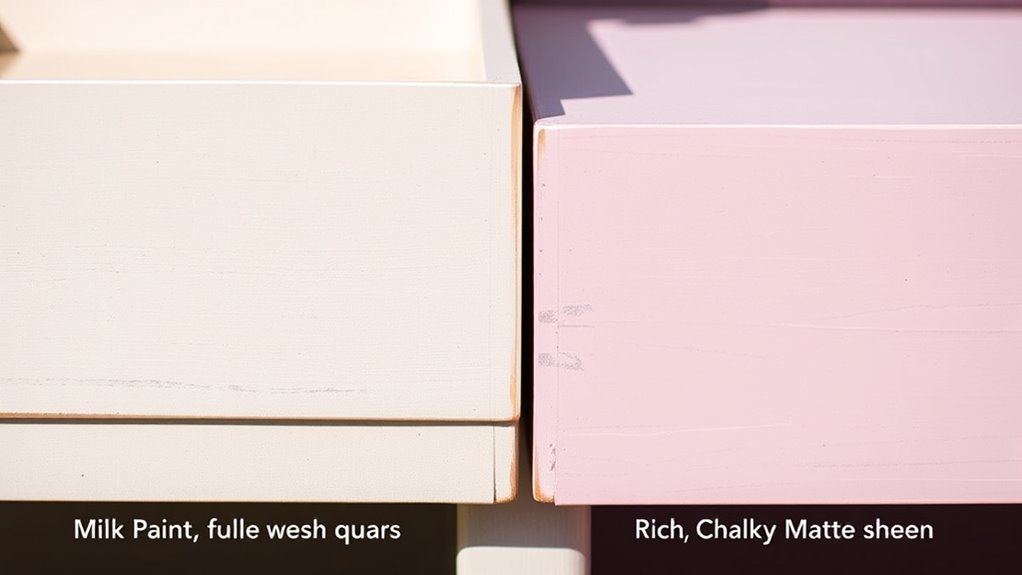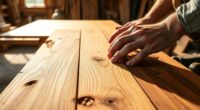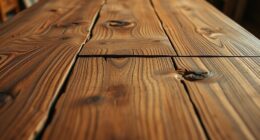If you’re choosing between milk paint and chalk paint, consider their unique qualities. Milk paint is natural, creates a matte, vintage look, and tends to chip and crack for a weathered effect. Chalk paint is synthetic, easy to apply, and offers a smooth finish that’s perfect for layering and distressing. Both can transform furniture, but understanding their differences helps you pick the right one for your style and project. Explore further to discover which option suits your DIY needs best.
Key Takeaways
- Milk paint is natural, organic, and produces a matte, vintage finish with natural chipping, while chalk paint is synthetic, acrylic-based, and offers a smooth, easy-to-distress surface.
- Milk paint often requires mixing with bonding agents for non-porous surfaces, whereas chalk paint adheres well with minimal prep and is more versatile across surfaces.
- Milk paint tends to crack and chip naturally, adding character, while chalk paint allows for quick layering, sanding, and sealing with wax for durability.
- Milk paint provides an authentic, textured look ideal for rustic or distressed styles; chalk paint offers a sleek matte finish suitable for shabby chic or modern vintage decor.
- Chalk paint dries faster and is easier for DIY projects, whereas milk paint may require more coats and careful application for best results.

When choosing between milk paint and chalk paint for your furniture or home projects, understanding their differences can help you make an informed decision. Both paints offer unique qualities that can dramatically change the look and feel of your pieces, but they also require different application techniques and result in distinct decorative finishes. Knowing these key differences allows you to select the right product for your specific project and desired aesthetic.
Milk paint is an organic, water-based paint made from natural ingredients like milk protein (casein), lime, and pigments. It’s celebrated for its ability to produce a matte, velvety finish that feels authentic and vintage. When applying milk paint, you typically use brushes or sprayers, and it’s often recommended to apply multiple thin coats for even coverage. Its application techniques tend to be more forgiving, especially if you want a distressed or weathered look, because milk paint tends to chip and crack naturally over time, adding character to your furniture. This characteristic makes it popular for creating a rustic or antique decorative finish, giving your pieces a sense of history and charm. Additionally, milk paint is highly versatile, allowing you to mix colors or add bonding agents to alter its finish or adhesion, especially on non-porous surfaces.
Chalk paint, on the other hand, is a synthetic, acrylic-based paint that has gained popularity for its ease of use and versatility. It’s known for providing a smooth, matte surface that’s perfect for achieving a shabby chic or vintage look without much prep work. Application techniques for chalk paint are straightforward—usually just brush it directly onto the surface with minimal sanding required beforehand. It adheres well to a variety of surfaces, including furniture with existing finishes, which makes it ideal for quick transformations. Chalk paint also lends itself well to decorative finishes like layering, distressing, and waxing. Once dry, you can easily sand certain areas to create a worn, aged appearance, or apply wax or other finishes to add durability and depth. Its smooth application and quick drying time make it a favorite for DIYers who want to achieve a professional-looking finish with minimal effort.
Frequently Asked Questions
Which Paint Is More Environmentally Friendly?
When choosing a paint based on environmental friendliness, you should consider sustainability factors and eco friendly ingredients. Milk paint often wins because it’s made from natural, biodegradable ingredients with minimal VOCs, reducing harmful emissions. Chalk paint, while low in VOCs, may contain synthetic components. By prioritizing eco-friendly ingredients and sustainability, you can make a more environmentally conscious choice that’s safer for both your home and the planet.
Can Both Paints Be Used Outdoors?
Is the outdoors a battleground for your paint? Both milk and chalk paints can withstand the elements with proper surface preparation. Milk paint offers excellent weather durability when sealed right, making it suitable for outdoor furniture. Chalk paint, however, may need extra sealing to withstand weather conditions. You must consider surface prep and sealing techniques to ensure your project endures outdoor wear and tear effectively.
How Long Does Each Paint Take to Dry?
You might wonder about drying time for these paints. Milk paint typically dries to the touch in about 30 minutes to an hour, but it requires a cure time of around 7 days for full hardness. Chalk paint dries faster, usually within 1 to 2 hours, with a cure time of about 21 days. Keep in mind, factors like humidity and temperature can affect both drying and cure times.
Are There Differences in Cost Between Milk and Chalk Paint?
You’ll find that chalk paint usually costs between $20 and $40 per quart, making it affordable for most DIY projects. Milk paint can be slightly cheaper, often around $15 to $30 per quart, but prices vary depending on quality and brand. When considering cost comparison, think about your budget considerations and desired finish. Both options fit different budgets, so choose the one that best aligns with your project scope and expense limits.
Which Paint Is Easier for Beginners to Use?
If you’re a beginner, chalk paint is generally easier to use because its application process is straightforward, often requiring minimal surface preparation. It’s forgiving and sticks well to various surfaces, making your project smoother. Milk paint can be trickier, needing careful surface prep and sometimes multiple coats. Chalk paint’s user-friendly nature helps you achieve professional-looking results faster, so it’s the better choice if you’re just starting out.
Conclusion
Now that you know the key differences between milk paint and chalk paint, you can confidently choose the right finish for your project. Think of milk paint as your trusty steed—authentic, rustic, and full of character—while chalk paint is your modern chariot—smooth, versatile, and sleek. Whichever you pick, remember that your creativity is the true magic wand. So go ahead, transform that old dresser, and make it shine like a shiny new penny in a bustling marketplace.











